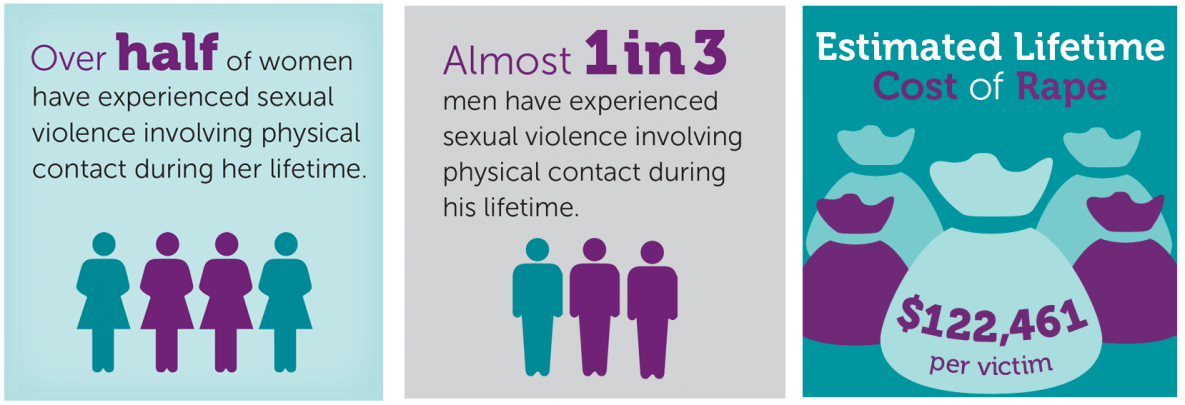Just yesterday, the Seattle Times reported that the U.N. women’s agency announced the start of a 16 day campaign against gender violence, encouraging tens of thousands of women to march on the International Day to End Violence Against Women. The campaign is a response to a serious issue: namely, how despite wide-spread movements against sexual violence (#MeToo and #TimesUp being the more prominant ones), sexual violence against women, according to the U.N. Women's agency, "continues to be normalized and embedded in our social environments."
And indeed, this problem not only exists but is far too prevalent: according to the CDC, about 1 in every 3 American women will suffer from physical sexual violence during their lifetime, with 1 in 5 experiencing attempted or completed rape. More recently, the U.N. has estimated that, world wide, approximately 15 million girls between the ages of 15 to 19 have been the victims of rape. Real numbers are likely much higher, as many women do not report sexual violence as a result of the trivializing of rape, victim-blaming, and objectification of women that pervades in many places due to rape culture.

However, though such a movement is both a welcome sight and a much needed push for activism against sexual violence against women, there is a problem with the campaign: it is too narrow, with the focus being exclusively on sexual violence against women. It says nothing about, and helps little with, sexual violence against men.
One might be forgiven, at least initially, for not thinking this as serious an issue: the aforementioned movements against sexual violence are almost exclusively started by and focusing on women. Likewise, reports of sexual violence in media and crime exclusively focus on said violence against women and children, not men. Indeed, one might go so are to say that, compared to women, gender violence isn't really an issue with men.
However, an examination of the statistics concerning sexual violence quickly disproves this: in America, 1 in 4 men experience physical sexual violence during their lifetime, with a further 1 in 38 being the victims of attempted or completed rape and 1 in 14 made to penetrate someone unwillingly, according to the CDC. Moreover, this only deals with sexual violence in normal every-day life: a report in 2008 found that there were an estimated 216,000 cases of male inmates being sexually assaulted in U.S. prisons that year. Comparatively, there was a total of 90,479 rape cases outside of prison, meaning there was more than double the amount of male inmate rape cases as total cases of rape in the US. Moreover, these estimates are highly conservative: many male victims prefer not to admit that they were raped, especially in the case of inmates where female staff members often initiate the rape.
OIG Sexual Abuse Investigations by Gender
FYs 2000-2004

Indeed, the problem of male rape is shockingly severe, especially in context of how little attention is given to it. Unlike with women, for whom rape has been a reality since ancient times, it has only recently been acknowledged that men can be raped; until 2012, just 7 years ago, the definition of rape was "carnal knowledge of a female forcibly and against her will." This, along with common conceptions of masculinity, led to male rape being trivialized to a horrific extent, with male rape being considered impossible and prison rape being treated as a joke. While jokes about "dropping the soap" seem innocent enough, they contribute to a general disregard and apathy towards prison rape: as Linda McFarlane, a social worker and Just Detention International's deputy executive director, put it, "Humor is part of the cultural attitude that (prison) is the one place where rape is okay."

In order to solve the problem of sexual violence, one must solve for much more than just sexual violence against women: even outside of prison, men make up a not-insignificant number of sexual violence victims. With male inmates taken into account, they account for the majority of cases in the US. Male victims, though, continue to remain hidden due to continuing cultural expectations concerning masculinity, the trivialization of prison rape, and outdated ideas viewing women as the only people capable of being raped.
So again, while the U.N.'s movement against sexual violence is a welcome one, it continues with the trend of ignoring male victims in favor of female ones, especially in the case of prison rape. Given the severity of the issue and the lack of visibility and support afforded to male rape victims, this truly ought be a central focus of the movement, especially if the U.N. is naming this campaign "Generation Equality Stands Against Rape." While it's greatly unlikely that the U.N. will broaden the purpose of this campaign, themselves subject to the same misconception of male rape as most people, hopefully further publicizing of male rape will eventually lead to these problems getting the attention and acknowledgement they deserve.

No comments:
Post a Comment